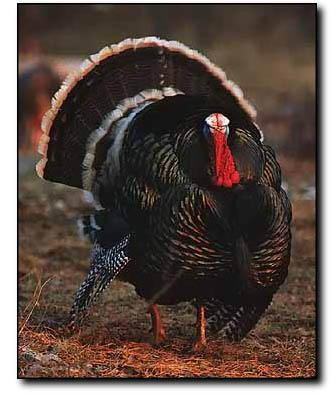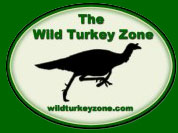| Background
 The
Merriam's wild turkey is found primarily in the ponderosa
pine, western mountain regions of the United States.
Within its suspected historic range in Arizona, New
Mexico and Colorado, the Merriam's was relatively
isolated from the other subspecies of wild turkey.
Current evidence supports the hypothesis that it was
a relative newcomer to western American wildlife when
the Europeans discovered it. It was named by Dr. E.W.
Nelson in 1900 in honor of C. Hart Merriam, the first
chief of the U.S. Biological Survey. The
Merriam's wild turkey is found primarily in the ponderosa
pine, western mountain regions of the United States.
Within its suspected historic range in Arizona, New
Mexico and Colorado, the Merriam's was relatively
isolated from the other subspecies of wild turkey.
Current evidence supports the hypothesis that it was
a relative newcomer to western American wildlife when
the Europeans discovered it. It was named by Dr. E.W.
Nelson in 1900 in honor of C. Hart Merriam, the first
chief of the U.S. Biological Survey.
Physical
Characteristics
Although approximately the same size
as the Eastern, the Merriam has different coloration.
It is black with blue, purple and bronze reflections.
White feathers on the lower back and tail feather margins
distinguish the Merriam from other subspecies of turkey.
Merriam’s appear to have a white rump due to pinkish
buff, or whitish tail coverts and tips. It closely resembles
the Gould's turkey but its tail margin is not usually
quite as pure white nor is the light margin of the tail
tip quite as wide as in the Gould's. The tail feathers
are very conspicuous when the gobbler struts against
a dark background. Toms have black-tipped breast feathers,
while the hens exhibit buff tips. Hens have a more extensive
white area on the wings giving a whiter appearance when
the wings are folded.
Habitat
and Range
Merriam's turkeys were historically found
in the ponderosa pine forests of Colorado, New Mexico,
and northern Arizona. They have been transplanted into
the pine forests of Utah, Idaho, Washington, Oregon,
California, Montana, Wyoming, Nebraska and South Dakota.
Merriam's turkeys can be found not only in ponderosa
pine forest but also other vegetation types in elevations
ranging from 3,500 to 10,000 feet. Their normal range
receives annual rainfall amounts averaging between 15
and 23 inches.
Life
History
The onset of breeding
is heralded by the commencement of gobbling as the
temperatures warm in the spring. Gobbling may start
late in February and early March. With a second peak
of gobbling occurring in early May. Toms may continue
to gobble into June. Hens mate once and may fertilize
all of the 8 to 12 eggs from one union. Incubation
takes 28 days. The hen does not begin to incubate
until all the eggs are laid and all the eggs hatch
within a single day. The young are capable of moving
from the nest soon after hatching. The hens and poults
spend the rest of the summer eating, loafing, and
gaining weight.
As winter approaches
hens and poults begin to form flocks with other hens
and poults. These become winter flocks. These flocks
winter as high up on the mountain as snow permits.
The cycle begins again in the spring.
Behavior
During winter Merriam's
turkey congregate in the pinyon pine-oak habitats
at the interface with ponderosa pine. If weather permits
they may even winter in the ponderosa pine. Deep snow
forces them to move to lower elevations. During spring
snow melt they again move up slope following the snow
line and breeding activity begins. Toms begin to gobble
and form harems. After mating, hens move into denser
habitat at higher elevation to lay and incubate eggs.
Toms and hens are not usually seen together except
during the breeding season which is late March to
early June. The remainder of the year they are in
similar habitat, but do not flock together.
During the summer months
hens and poults spend much of their time searching
for bugs and seeds in small forest openings and forest
meadows. As winter approaches, oaks and pinyon ripen.
The hens, poults, and toms feed on these mast crops.
With the onset of winter they begin to move out of
the snow into pine stringers at lower elevations.
|

